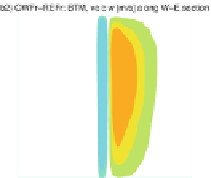Civil Engineering Reference
In-Depth Information
10
3
10
3
m. Here, the comparison of the
which shows +5.86
and
9.16
extreme values of
ζ
results in an about 35 % weaker
ζ
effect in the case of BTM,
but in relation to the mean
ζ
effect, the BTM simulation is 4.54 % weaker than the
master simulation.
The weaker effect on surface elevation can be explained using the
vertical
velocity component
. The existence of the OWF effect on the vertical velocity
component indicates that the vertical motion occurs as a cause of
ζ
dipole forma-
tion. The wind wake causes a wake in ocean flow, which provokes congestion of
mass, and the downwelling is a compensating reaction.
The impact on vertical velocity component
w
by BTM has a maximum of
1.0
10
5
m/s in 3.0-m depth,
Fig.
5.10
. While here the minimum, downwelling, is nearly equal to the master
10
5
m/s and a minimum speed of
1.2
Fig. 5.10 12-turbine OWF effect (OWFr-REFr) on the vertical velocity component w for (a1)-
(a3) master run, means barotropic mode (Master), for (b1)-(b3) run under barotropic conditions
(BTM) and (c1)-(c3) the difference between Master and BTM. Results are presented in the
horizontal at 12-m depths (a1-c1) and along the cross-sections W-E (a2-c2) and S-N (a3-c3)
through the OWF. The OWF is placed around
x
0. BTM results in a smoother and intensified
vertical velocity, especially in deeper depths and even in 12-m depths. In the case of Master,
maximal changes are concentrated around the 12-m layer
¼
y
¼














































































































































































































































































































































































































































































































































































































































































































































































































































































































































































































































Search WWH ::

Custom Search